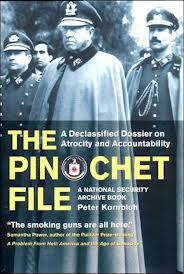Source: NACLA
The Academy Award-nominated film “NO” re-opens a window on an inspirational moment in Latin American history, when Chileans used the ballot box to bring down the notorious dictatorship of General Augusto Pinochet in a 1988 plebiscite. The film portrays the successful media campaign behind the “NO” vote through the story of fictional ad man René Saavedra, who markets the anti-regime cause like a soft drink commercial.
Even more interesting is some of the history surrounding the event that the film leaves out, and the continued relevance of this historical moment to events in Chile today.
Genaro Arriagada, the brilliant PDC (Christian Democratic Party) tactician who directed the actual “NO” campaign, calls the idea that Pinochet lost the plebiscite to some TV commercials with a rainbow logo “a gross oversimplification” that ignores the reality of extensive organizing work by Chilean popular movements, unions, and political parties. In fact, popular resistance to the regime had begun to coalesce several years earlier around the anticipated plebiscite, which was mandated by Pinochet’s 1980 Constitution. The plebiscite was intended as an instrument to legitimize and perpetuate Pinochet’s rule for another eight years.
A coalition of 14 Chilean political parties, ranging from leftist to center-right, sponsored a massive grassroots voter education drive that became the “NO” campaign, targeted to likely pro-democracy voters. The campaign registered an astounding 7.5 million voters—more than 90% of the electorate—overcoming widespread popular skepticism, fear of repression, and reluctance to legitimize the military Constitution through the ballot box. While Pinochet was forced to allow both the “NO” and the “SI” campaigns 15 minutes of free TV time to present their ads each night, as depicted in the film, the “SI” message received continuous support through the government-controlled media. In the end, though, 55% of Chilean voters cast their ballots against Pinochet.
According to the non-profit National Security Archive, Pinochet planned to foster violence, annul the plebiscite, and reassert dictatorial powers if he lost the vote, a story told by declassified documents posted by the Archive (but only hinted at in the film). Pinochet was described in a CIA memo as “nearly apoplectic” at the election results. The autogolpe (self-coup) plan was thwarted when the other members of the military junta refused to back Pinochet.
Above all, Pinochet feared that a civilian government would cooperate with the United States in pursuing the case of Orlando Letelier, a minister in the leftist government of Salvador Allende who was assassinated on the streets of Washington DC in 1976. The assassination is now known to have been carried out under Operation Condor, a coordinated effort by 6 Latin American dictatorships, led by Pinochet, to eliminate political dissidents living in exile.
Almost 40 years later, Operation Condor is the subject of a landmark trial involving 25 generals, now taking place in Argentina. While the head of Chile’s secret police served seven years for Letelier’s murder, Pinochet (who died in 2006) was never held accountable for this, or any other, international terrorist act or human rights crime.
In the film, René’s rightwing boss, who is working for the “SI” campaign, assures René that the “Americans are still with us.” In fact, the U.S. government, which worked covertly to undermine Allende and gave massive aid to Pinochet in the junta’s early years, actively supported the “NO” campaign.
 Through the National Endowment for Democracy (a quasi-government agency), the National Democratic Institute, and the AFL-CIO, the United States channeled $1.6 million for voter registration, education, and computerized polling. A U.S. political communications firm designed the voter registration plan, down to the precinct level. U.S. media consultants brought Madison Avenue skills to the TV ad campaign and provided strategic planning, training, and materials.
Through the National Endowment for Democracy (a quasi-government agency), the National Democratic Institute, and the AFL-CIO, the United States channeled $1.6 million for voter registration, education, and computerized polling. A U.S. political communications firm designed the voter registration plan, down to the precinct level. U.S. media consultants brought Madison Avenue skills to the TV ad campaign and provided strategic planning, training, and materials.
What explains the U.S. government’s about-face? It seems that by the mid-1980s, Pinochet’s increasingly belligerent dictatorship had become a political liability for the Reagan administration. Within Chile, the regime’s ever more repressive tactics were fostering a growing insurgency, revitalizing the very leftist forces that the Pinochet, with U.S. support, had sought to eliminate. Moreover, continued U.S. backing for Pinochet was jeopardizing Reagan’s efforts to gain Congressional support for U.S. counter-insurgency operations in Central America, including the contra war in Nicaragua, in the name of democracy promotion. (These details, along with many declassified documents, can be found in “The Pinochet File,” a National Security Archive Book by Peter Kornbluh.)
Consistent with U.S. interests, both the structure of the “NO” campaign and its outcome marginalized the leftist groups that had prevailed under Allende. The “NO” campaign was dominated by the PDC, on the center-right of Chile’s political spectrum. The formal political coalition supporting the “NO” excluded the Communist Party and several other radical leftist groups, although most of these groups did participate in the grassroots campaign.
Patricio Aylwin, the PDC spokesman for the “NO,” who became president in the election following the plebiscite, had bitterly opposed Allende in 1970 and initially supported the military coup. The democratically-elected Aylwin government came into power by accepting the legitimacy of the junta’s 1980 constitution, which many members of the “NO” coalition had rejected—a legacy that continues to haunt Chile to this day.
It’s interesting to speculate whether the “NO” campaign could have succeeded without U.S. funding and assistance, and how different Chile’s history might have been if it had failed. That’s a subject for another movie.
Emily Achtenberg is an urban planner and the author of NACLA’s weekly blog Rebel Currents, covering Latin American social movements and progressive governments (nacla.org/blog/rebel-currents).
